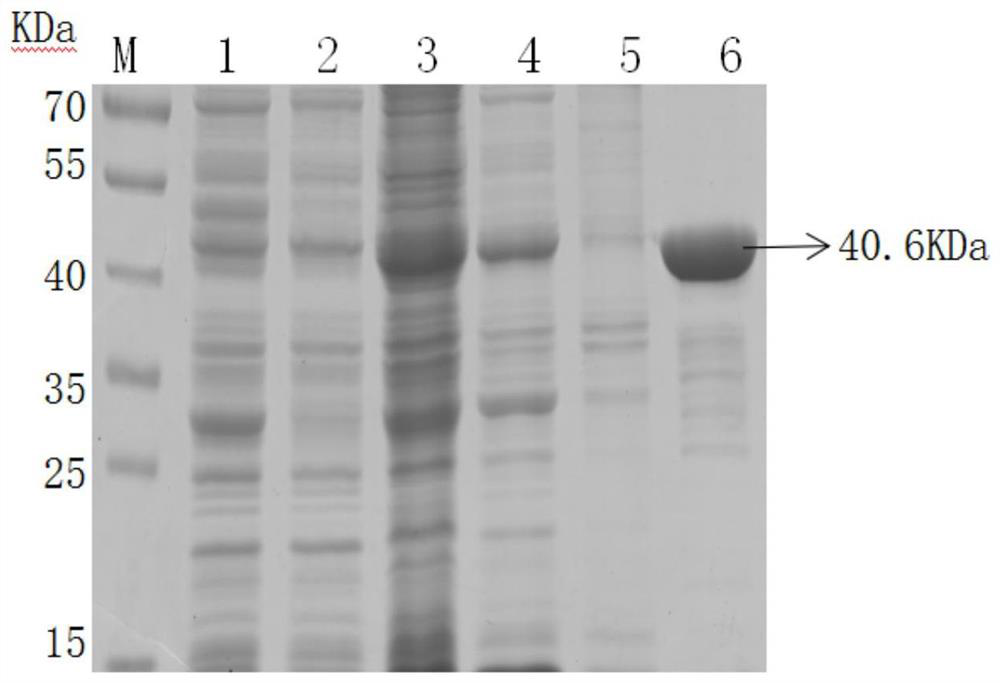Porcine lawsonia intracellularis IPMA antigen detection method and application thereof
A technology for antigen detection and Lawsonia, applied in chemical instruments and methods, immunoassays, biological tests, etc., can solve problems such as false negatives, low content of Lawsonia intracellulare, and limited
- Summary
- Abstract
- Description
- Claims
- Application Information
AI Technical Summary
Problems solved by technology
Method used
Image
Examples
Embodiment 1
[0070] Embodiment 1: Prokaryotic expression and purification of SodC protein
[0071] (1-1) Using the attenuated vaccine culture of Lawsonia intracellularis suis as a template, design a pair of specific primers SF / SR for amplification:
[0072] SF: 5'-GGATCCATGGAATAAAACAGAGTATAGG-3' (SEQ ID NO.1);
[0073] SR: 3'-CTCGAGCTAGTTTGGTATAACACCAC-5' (SEQ ID NO. 2);
[0074] (1-2) Use pGex-6p-1 as the carrier, digest pGex-6p-1 with SacI and XhoI, connect the amplified product of step (1), construct the pGex-6p-1-sodc recombinant plasmid, transform BL21, and obtain the recombinant Bacteria pGex-6p-1-sodc / BL21;
[0075] Inoculate the recombinant strain pGex-6p-1-sodc / BL21 into 3ml of LB liquid medium containing ampicillin and chloramphenicol at a ratio of 1:100, culture at 37°C with shaking at 180rpm until OD 600nm When the value is about 0.5, add a final concentration of 0.5mMIPTG, induce at 16°C, 90rpm for 18h, centrifuge at 8000rpm, 4°C for 10min to collect the cells, wash the cel...
Embodiment 2
[0077] Embodiment 2: the preparation of the polyclonal antibody of SodC protein and Western-blot analysis
[0078] The purified SodC protein was mixed with an oil adjuvant (ISA206 oil adjuvant) at a ratio of 1:1, emulsified and prepared as an immunogen, and the New Zealand white rabbits were immunized by multi-point subcutaneous injection on the back, with an immunization dose of 1 mg / rat. On the 14th and 21st days after immunization, booster immunization was given once, and the immunization dose and immunization route were the same as the first immunization. On the 7th day after the third immunization, blood was collected from the ear vein of the rabbit, and the serum titer was determined by conventional ELISA method. The coating concentration of SodC protein was 20ug / ml, and the serum to be tested was diluted from 1:100 to 1:100. ×2 30 , the dilution factor of HRP-labeled goat anti-rabbit IgG is 1:5000, and the OD is determined after TMB color development 450nm The absorba...
Embodiment 3
[0079] Example 3: Cultivation of Lawsonia intracellulare
[0080] (1) Take out the McCoy cells from liquid nitrogen, put them into 37°C water to melt quickly, add the melted cells into DMEM high glucose medium containing 10% fetal bovine serum, 37°C, 5% CO 2 Cultivate in an incubator for 24 hours. After the cells are covered with a single layer, discard the culture medium, wash with PBS for 3 times, digest with 0.25% trypsin in mass ratio, stop digestion when a small amount of cells fall off, and add FBS containing 10% in volume ratio The DMEM cell culture medium was repeatedly blown several times to disperse into single cells, and an appropriate amount of cell liquid was sucked into another cell bottle for subculture.
[0081] (2) When McCoy is cultured to a density of about 30%, discard the DMEM cell culture solution containing 10% FBS in volume ratio, and add Lawsonia intracellulare after 10-fold dilution of the inoculated culture solution of Lawsonia intracellulare. For a...
PUM
 Login to View More
Login to View More Abstract
Description
Claims
Application Information
 Login to View More
Login to View More - R&D Engineer
- R&D Manager
- IP Professional
- Industry Leading Data Capabilities
- Powerful AI technology
- Patent DNA Extraction
Browse by: Latest US Patents, China's latest patents, Technical Efficacy Thesaurus, Application Domain, Technology Topic, Popular Technical Reports.
© 2024 PatSnap. All rights reserved.Legal|Privacy policy|Modern Slavery Act Transparency Statement|Sitemap|About US| Contact US: help@patsnap.com










